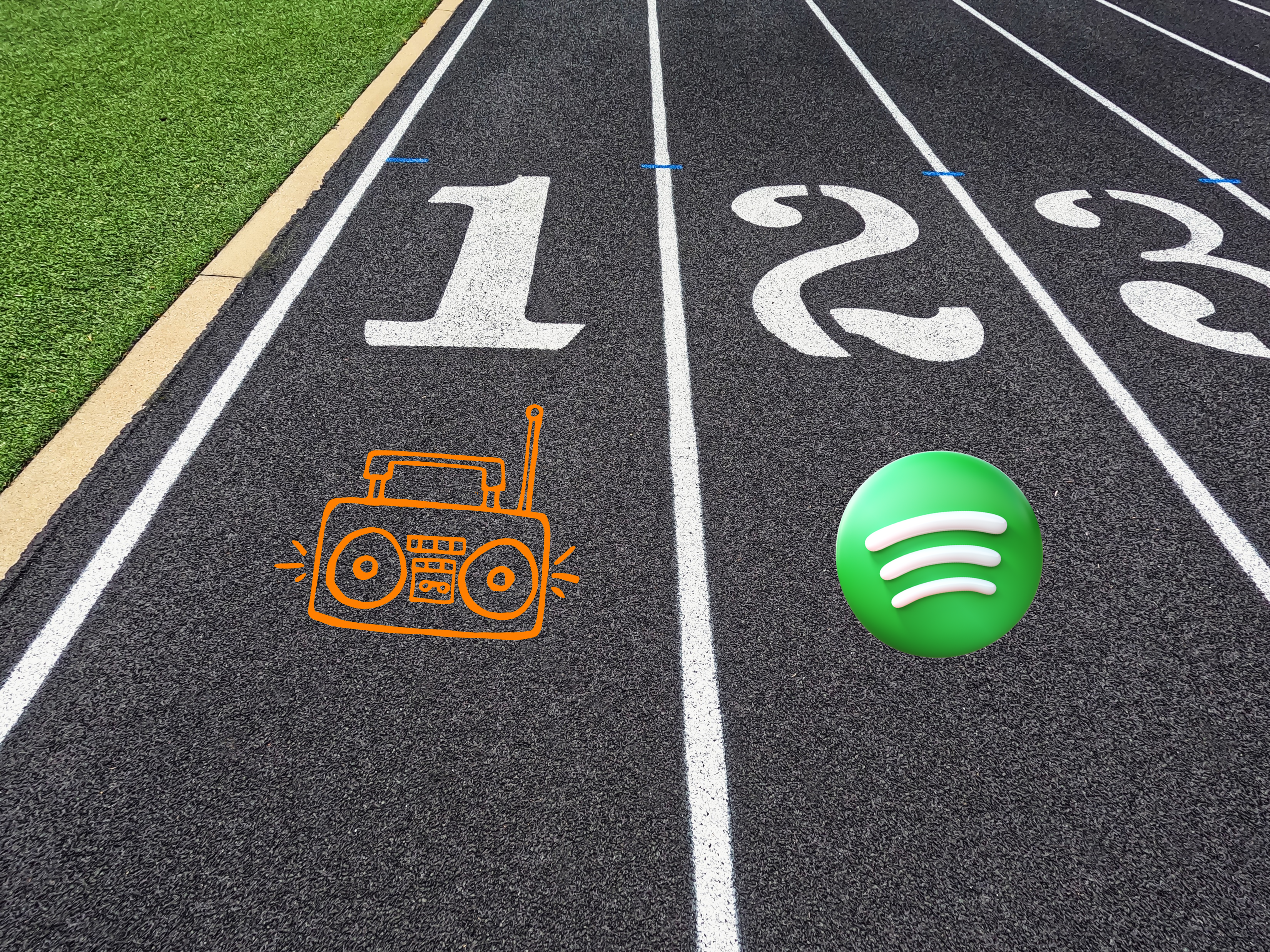
Today’s marketing lesson comes courtesy of your nearby grocery store, whether it’s part of a major network of stores like Kroger or a hometown store that feels like part of your community. The former is ubiquitous in the U.S., but the latter is more of a rarity – unless you live in region like Florida, Texas, Western New York, and other pockets of this country where independent grocers have made their presence known.
What do grocery stores have to do with broadcast radio? Indie operators like H-E-B are proving you don’t have to be part of a giant conglomerate in order to carve out a success.
But it helps if you stay in your lane.
You’ve never heard of H-E-B? Then you probably haven’t spent much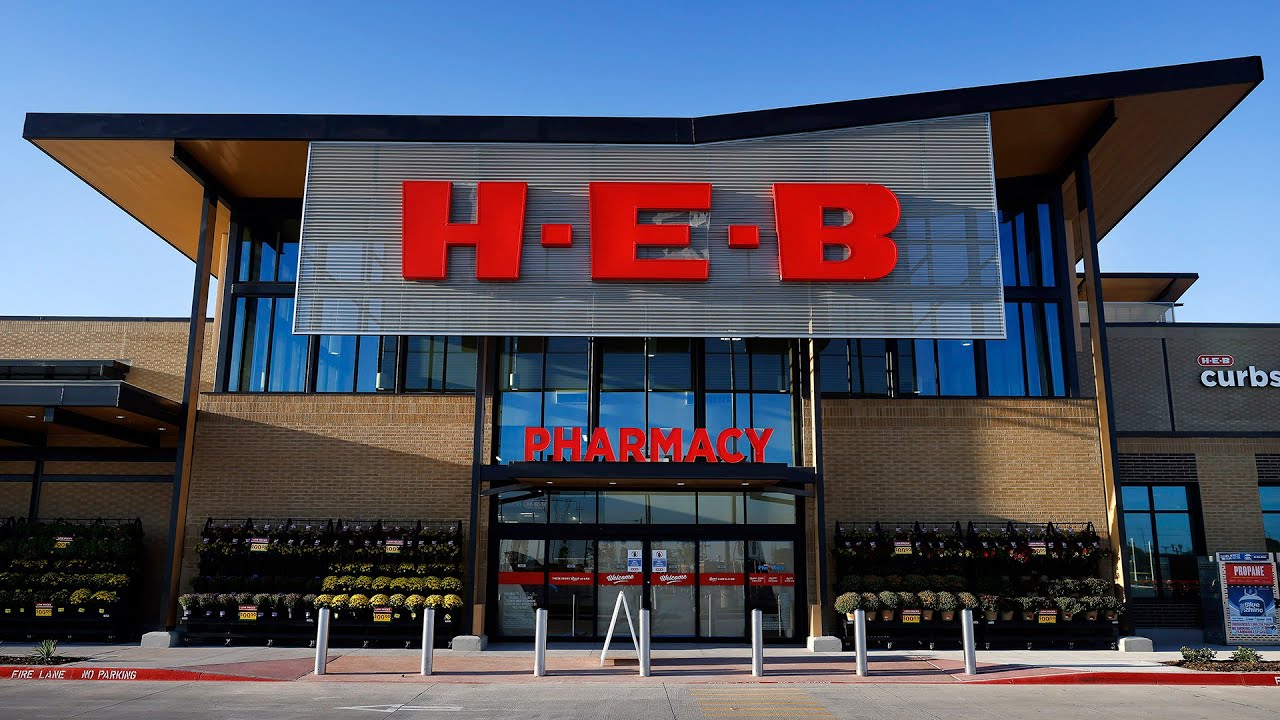 time in Texas where these stores are like home to thousands of the locals who have come to count on groceries that sell more than staples like fruits, meats, veggies, and cereal – they provide a sense of place.
time in Texas where these stores are like home to thousands of the locals who have come to count on groceries that sell more than staples like fruits, meats, veggies, and cereal – they provide a sense of place.
Sherwood News reporter J. Edward Moreno writes the story of how H-E-B goes up against Kroger, Albertsons, and other grocery behemoths – and emerges a winner. For radio, they provide an object lesson of how smaller, regional broadcasters can not only survive, but thrive, even when competing against radio companies that own hundreds of stations and other media assets.
You can see the footprint of H-E-B, along with other regional plays, including Publix in the Southeast – but concentrated in Florida – as well as Hy-Vee in the Midwest:
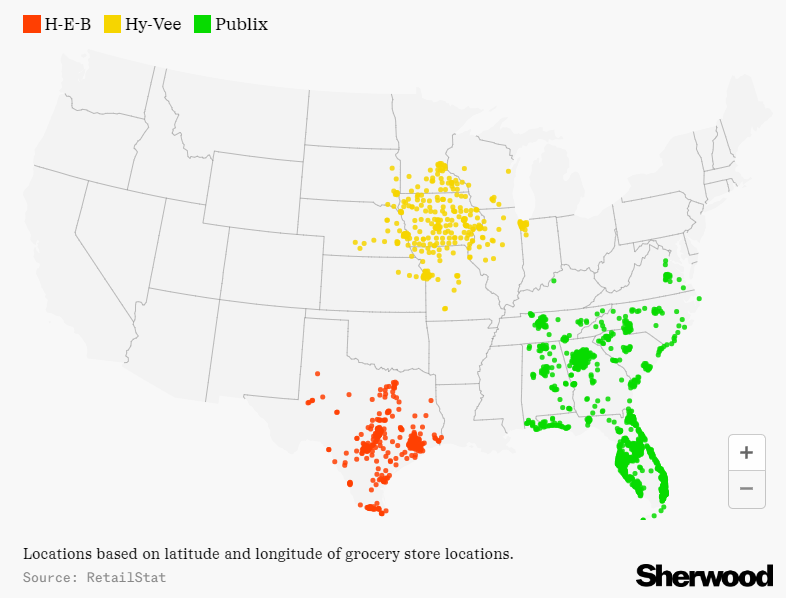
Moreno says it’s about “staying in your lane.” That translates to not trying to get too big, focusing your efforts in places where you know the turf…and the people.
Right now, Kroger is trying to merge with Albertsons which would amount to “the biggest supermarket merger in U.S. history,” according to ABC News. Why do they need to pull off this gargantuan transaction? To compete with an even bigger competitor – Walmart.
So, how can an H-E-B survive in this environment where elephants are fighting? As Moreno explains, “Some grocery giants think massive scale is the only way to win. H-E-B begs to differ.” And his story points to the ways a regional play – staying in their lane – is benefitting regional players like H-E-B.
As Chris Brunt (who discovered this story) told me, the H-E-B is analogous to smaller companies duking it out with giant radio conglomerates like iHeart and Audacy or Spotify and SiriusXM in their efforts to stay local and relevant.
Consider the following stats and facts, and then think about how they parallel in radio:
- Great “ratings” – Supermarkets don’t get Nielsen monthlies but they’re rated by something called the Dunnhumby’s Retailer Preference Index or the RPI. Like the Net Promoter score, it
 ranks grocers based on customer opinions. For the past two years, H-E-B has been ranked #1 – an impressive performance over the big players in the space. Imagine what it’s like to call your friends in the business and brag about your great RPI.
ranks grocers based on customer opinions. For the past two years, H-E-B has been ranked #1 – an impressive performance over the big players in the space. Imagine what it’s like to call your friends in the business and brag about your great RPI. - Charity begins at home – One of the signature differences of H-E-B stores is their commitment to local causes, including disaster relief when one of their communities is hard hit. They are also great local citizens when it comes to how they treat employees. Moreno reports they often pay more than the big players in town. We know the power of both metrics in radio. Being a great place to work keeps you competitive, while giving back to the community speaks volumes about what a brand stands for.
- Know the turf – When your footprint is all about a defined geographic area, it gives you a chance to superserve your local community. H-E-B stores know its markets better than the massive chains or big box stores, giving them the opportunity to provide unique services.
- Know the customer – These go hand in hand, but it’s easy to program a radio station in your hometown – an advantage
 I enjoyed while programming WRIF here in Detroit. Decades later, Jade Springart (pictured) has that same advantage.
I enjoyed while programming WRIF here in Detroit. Decades later, Jade Springart (pictured) has that same advantage. - Own the streets – A staple in radio wars, H-E-B can play the guerilla game. As former company exec Scott McClelland explains, “We did stuff that a big national competitor couldn’t, wouldn’t, or didn’t, and we knew we had an advantage because as Texans we eat differently than people in Arkansas, and we live differently.”
- Unique content – Because they know the tastes of their customers,
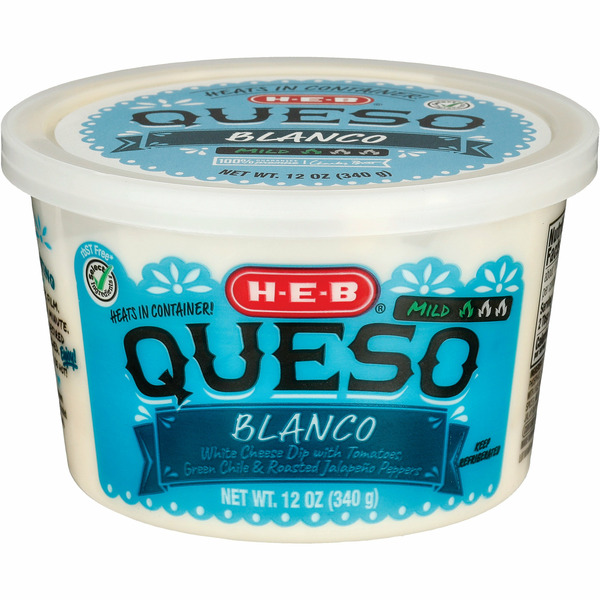 individual H-E-B stores can take a long tail approach with specialty products unique to give in stores. Writer Moreno wrote about Whataburger brand spicy ketchup as an example (who knew?). Not unlike a Trader Joe’s, the Sherwood News story reports H-E-B sells $1 million of its brisket queso dip each week.
individual H-E-B stores can take a long tail approach with specialty products unique to give in stores. Writer Moreno wrote about Whataburger brand spicy ketchup as an example (who knew?). Not unlike a Trader Joe’s, the Sherwood News story reports H-E-B sells $1 million of its brisket queso dip each week. - Be hyper-local – While Walmart stores don’t change whether you’re in Lubbock, Louisville, or Lansing, H-E-B outlets can look drastically different from one another depending on your location.
- Wave the local flag – Most people are intensely proud of where they live. Of course, this describes Texans. H-E-B plays
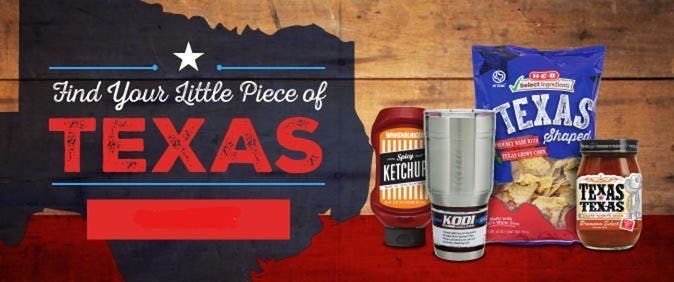 right into the Texas pride mindset throughout their stores, even naming products like cheese after cities all over the state. In the same way the crowd goes nuts when a musical entertainer screams out a “Hey, FILL IN CITY OR TOWN HERE,” a radio station or grocery store chain can channel that hometown enthusiasm.
right into the Texas pride mindset throughout their stores, even naming products like cheese after cities all over the state. In the same way the crowd goes nuts when a musical entertainer screams out a “Hey, FILL IN CITY OR TOWN HERE,” a radio station or grocery store chain can channel that hometown enthusiasm. - Lean into the passions of your customers – We may not be able to quantify love for a brand, but we know it when we see it. H-E-B stores are famous for turning their consumers into fans. In fact, several observers point out H-E-B has a cult-like following – not bad for a grocery store chain that’s been around for nearly 125 years. This 2-minute video celebrating the opening of a new store in McKinney, Texas, says it all. No one feels this way about their local Kroger’s.
- The private advantage – Of course, there are upsides for being a publicly-traded company, but when you’re private, the pressures are simply lessened whether its making the margins or trying to prove your value to Wall Street. The founder of another local grocery chain, Randall Onstead puts it this way: “…it’s harder to be attuned to local trends and consumer habits, and the desire to meet Wall Street expectations can get in the way of long-term goals.” And when it comes privately held grocery stores, “They don’t have the pressures of living quarter to quarter.” Amen.
It is fascinating how many of the same strategic principles apply – whether we’re talking grocery stores or radio stations. The competitive arenas are similar, and so are the solutions.
A key to any competitive situation is to assess the conditions, know your staff, your product, and your customer and adjust accordingly. Whether you work for iHeart or a mom & pop radio station, each has its advantages – and its downsides.
Learning how to “play your cards” everyday, particularly as market conditions change, is the secret to sustainability and profitability.
And misfortune can impact even the best businesses and brands. But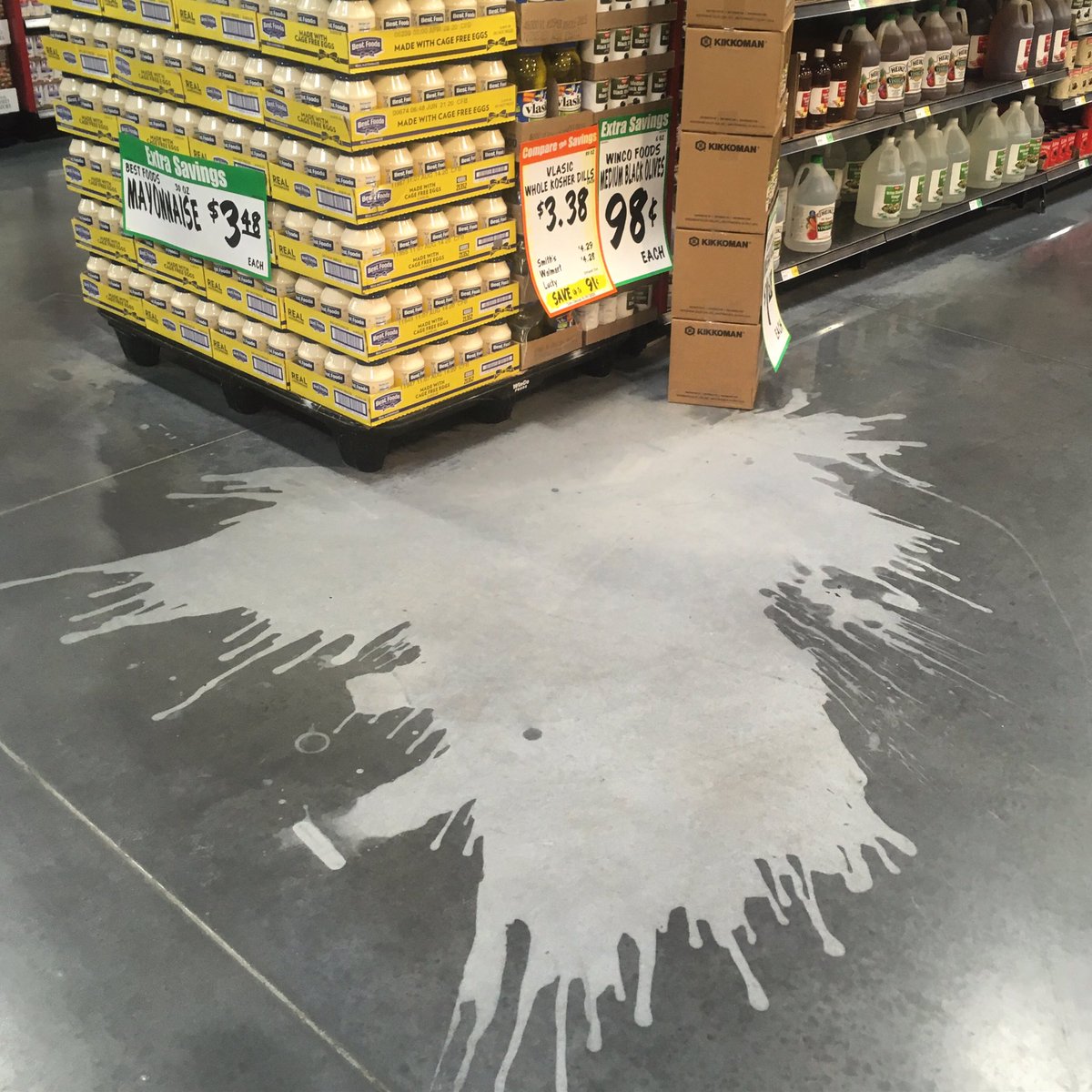 working down the H-E-B checklist can help.
working down the H-E-B checklist can help.
As Moreno reminds us “scale isn’t everything.”
So, stay in your lane. And steer clear of aisle 3. Somebody dumped a gallon of 2% milk.
P.S. Right about now, you may be wondering how H-E-B got its name, and what those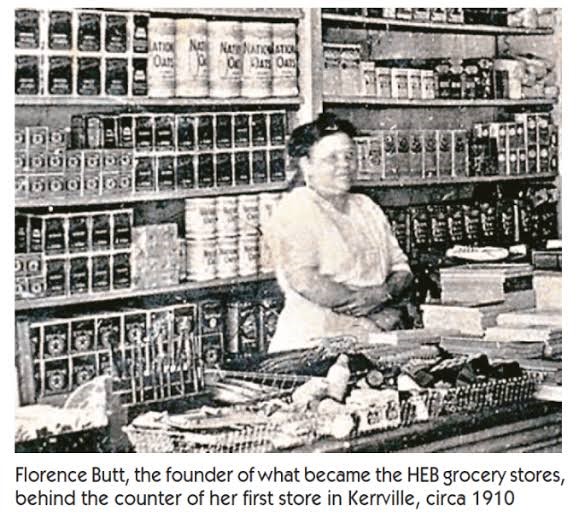 letters stand for. The grocery stores are named after their founders, Howard E. Butt and his mother Florence (pictured). It turned out she actually opened the first store in 1905 when her husband, Clarence, contracted tuberculosis.
letters stand for. The grocery stores are named after their founders, Howard E. Butt and his mother Florence (pictured). It turned out she actually opened the first store in 1905 when her husband, Clarence, contracted tuberculosis.
- A 2020 Lesson?It Could All Be Gone In A Flash - April 24, 2025
- How AI Can Give Radio Personalities More…PERSONALITY - April 23, 2025
- Can Radio Afford To Miss The Short Videos Boat? - April 22, 2025




Fred, LOVED this one! Especially liked the map showing the regional locations of super markets that are smart enough to operate in specific areas rather than seeking world dominance like several radio companies I can think of. I heard that Publix was moving up as far as Tennessee, but it looks like they’re now up to Louisville, KY. H-E-B seems to be content to just stay within the boundaries of The Lone Star state. I experienced my first HyVee in Minneapolis. That store is mind-blowing. They had various food venues in the market with tables and booths to enjoy the food!!! The other incredible chain that’s the mother-load of all travel stops is Buc-ee’s, another Texas-based mega-chain that has the whole country buzzing! It’s truly a destination, kinda like appointment listening.
These stores give you a senese of appreeciation for what can be done locally, similar of course to local radio at its best. Have not been to Buc-ee’s, but will check it out next time I’m in the Lone Star State.
You could also apply this to convenience-store chains. Here in the mid-Atlantic, we’re fortunate to have several great regional chains that compete but also have their own niches–most notably, Wawa, Sheetz, Royal Farms, and Rutter’s. There are plenty of good chains in the Midwest and/or South, as well–like Casey’s, Kum & Go, Kwik Trip/Kwik Star, the unrelated QuikTrip, and RaceTrac.
Back to grocery stores, many folks around here are fans of Wegmans. Likewise, the U.S. operations of Lidl are based here–so that chain has a significant presence locally. Plus, there are also some well-regarded chains that are closer to the Whole Foods style–like Sprouts, The Fresh Market, and MOM’s Organic Market.
I love Wegman’s. They do a wonderful job of serving their regions. When I lived in Iowa, we had Barlow’s, another great local chain.